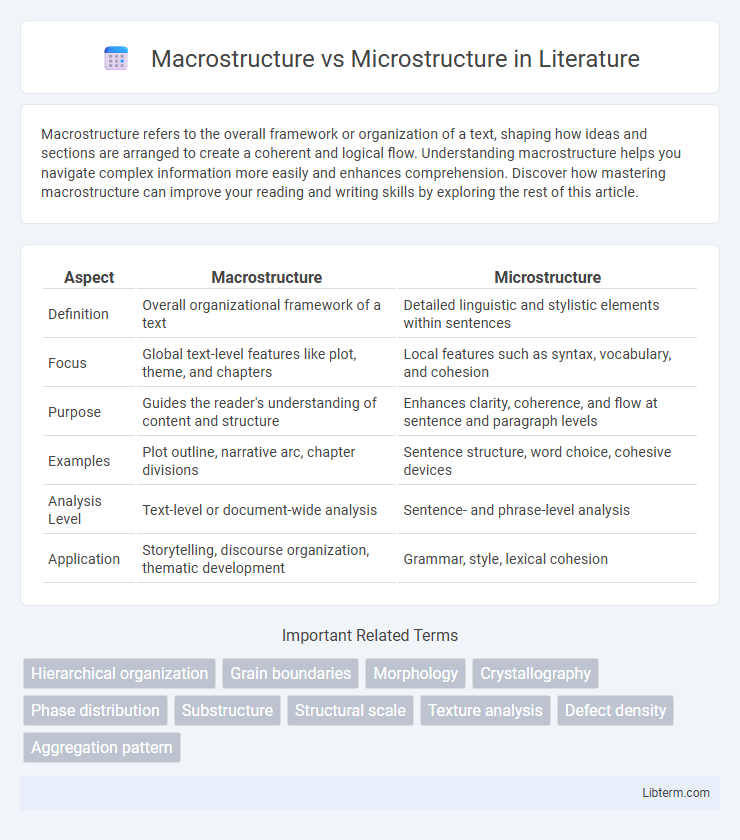Macrostructure refers to the overall framework or organization of a text, shaping how ideas and sections are arranged to create a coherent and logical flow. Understanding macrostructure helps you navigate complex information more easily and enhances comprehension. Discover how mastering macrostructure can improve your reading and writing skills by exploring the rest of this article.
Table of Comparison
| Aspect | Macrostructure | Microstructure |
|---|---|---|
| Definition | Overall organizational framework of a text | Detailed linguistic and stylistic elements within sentences |
| Focus | Global text-level features like plot, theme, and chapters | Local features such as syntax, vocabulary, and cohesion |
| Purpose | Guides the reader's understanding of content and structure | Enhances clarity, coherence, and flow at sentence and paragraph levels |
| Examples | Plot outline, narrative arc, chapter divisions | Sentence structure, word choice, cohesive devices |
| Analysis Level | Text-level or document-wide analysis | Sentence- and phrase-level analysis |
| Application | Storytelling, discourse organization, thematic development | Grammar, style, lexical cohesion |
Introduction to Macrostructure and Microstructure
Macrostructure refers to the overall organization and global framework of a text, influencing how main ideas and sections are arranged to support coherence and comprehension. Microstructure involves the finer linguistic details such as sentence-level syntax, word choice, and cohesive devices that connect ideas within paragraphs. Understanding both macrostructure and microstructure is essential for effective communication, as they jointly shape the clarity and flow of written or spoken discourse.
Defining Macrostructure: The Big Picture
Macrostructure refers to the overarching organization and major components that form the big picture of a text or system, encompassing main ideas and global patterns. It highlights the framework by which information is grouped into chapters, sections, or large thematic units, providing clarity and coherence at a broad level. Understanding macrostructure enables effective synthesis and navigation of complex content by focusing on primary concepts and their hierarchical relationships.
Understanding Microstructure: The Fine Details
Microstructure refers to the intricate arrangement of grains, phases, and defects within a material, observable only through microscopic techniques such as electron microscopy. Understanding microstructure is essential for predicting mechanical properties, corrosion resistance, and overall material performance in various applications. Detailed analysis of microstructure enables engineers to optimize heat treatment processes, alloy compositions, and manufacturing methods to enhance material quality at the microscopic level.
Key Differences between Macrostructure and Microstructure
Macrostructure refers to the overall framework or global organization of a text, encompassing main ideas, themes, and the arrangement of content at a large scale. Microstructure involves the detailed linguistic elements such as sentence structure, word choice, and grammar that shape meaning at the sentence or phrase level. Key differences include scope, where macrostructure addresses big-picture coherence and narrative flow while microstructure focuses on local clarity and linguistic accuracy, influencing readability and reader engagement differently.
Importance of Macrostructure in Text and Communication
Macrostructure in text and communication refers to the overall organization and global coherence, enabling effective message delivery and facilitating reader comprehension. A well-developed macrostructure guides the audience through the main ideas and logical flow, enhancing retention and engagement. In contrast to microstructure, which focuses on sentence-level details, macrostructure shapes the framework that supports meaningful interpretation across paragraphs and sections.
Role of Microstructure in Clarity and Cohesion
Microstructure plays a crucial role in enhancing clarity and cohesion by organizing sentences and paragraphs to ensure logical flow and readability. It involves the precise use of transitional phrases, consistent terminology, and well-structured syntax, which together create clear connections between ideas. Effective microstructural elements prevent ambiguity and reinforce the overall coherence of a text, facilitating better understanding for readers.
Macrostructure vs. Microstructure in Scientific Writing
Macrostructure in scientific writing refers to the overall organization and framework of a document, including sections such as the abstract, introduction, methodology, results, and conclusion, which collectively guide the reader through the research narrative. Microstructure focuses on sentence-level and paragraph-level elements like clarity, coherence, grammar, and precise terminology that enhance readability and ensure accurate communication of complex ideas. Effective scientific writing requires a balance between macrostructural coherence to maintain logical flow and microstructural precision to support clarity and comprehension of detailed scientific content.
Impact on Reader Comprehension
Macrostructure organizes the overall framework of a text, such as chapters and sections, guiding the reader through a coherent flow of ideas and enhancing comprehension by providing clear context. Microstructure involves sentence-level elements like word choice, syntax, and cohesion, which directly affect the clarity and ease of understanding within individual paragraphs. Effective alignment of macrostructure with microstructure improves reader engagement and retention by ensuring continuity and precision throughout the text.
Strategies for Balancing Macrostructure and Microstructure
Effective strategies for balancing macrostructure and microstructure involve aligning overarching organizational goals with detailed content elements to ensure coherence and clarity. Utilizing hierarchical outlines helps structure main ideas while refining sentence-level syntax and vocabulary enhances readability and engagement. Employing tools like mind mapping combined with editing software supports simultaneous management of global flow and local precision in text development.
Conclusion: Integrating Macrostructure and Microstructure
Integrating macrostructure and microstructure enhances overall text coherence and clarity by aligning global organization with detailed linguistic elements. Effective communication arises from balancing the broader thematic framework with precise sentence-level choices that guide reader understanding. This synthesis supports both comprehensive flow and nuanced meaning, optimizing textual impact across diverse contexts.
Macrostructure Infographic

 libterm.com
libterm.com